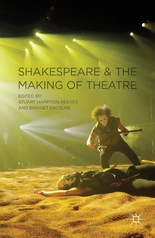
January 3, 2013, by Peter Kirwan
Shakespeare and the Making of Theatre
The blog has been quiet for a while, which is the unfortunate result of a dearth of new early modern theatre in the East Midlands and a very busy December at work. Coming up later in 2013 will be reviews of new shows by Propeller, the RSC, Shakespeare’s Globe, Shakespeare at the Tobacco Factory and the Union Theatre, but for now I wanted to quickly give a mention to a fantastic new resource.
Stuart Hampton-Reeves and Bridget Escolme’s new collection Shakespeare and the Making of Theatre (Palgrave, 2012) comes out of the work done over years by a network of scholars calling themselves ShIP (Shakespeare in Performance/Production), a group I’ve been on the edges of. Bringing together many of the most exciting names in current Shakespearean performance criticism, this compact volume features twelve short essays that go back to the roots of Shakespeare’s theatremaking practice, combining current thinking on early modern theatrical practice and insights drawn from modern performance.
What makes the volume particularly useful as a teaching resource is the focus on distinct elements of performance. From Escolme’s own chapter on ‘Costume’ to Farah Karim-Cooper’s on ‘Props’, from Peter Holland’s discussion of ‘Openings’ and Paul Prescott’s of ‘Endings’ to Sarah Werner’s attention to ‘Audiences’, the collection takes the time to dig through the language to uncover how the plays depend upon and dictate modes of performance. While Shakespeare’s language inevitably remains the primary material that gives ‘clues’ to performance (to borrow Margaret Jane Kidnie’s term from the excellent opening chapter), the authors show how this language (or even the lack of it, as in Robert Shaugnessy’s fascinating treatment of ‘Silence’) shapes three-dimensional live performance events.
The methodologies vary according to subject matter: Prescott’s chapter, for example, makes extensive use of quantitative data drawn from a survey of all the plays, while Hampton-Reeves’s significant piece on stage fighting (a hugely neglected form of practice that Hampton-Reeves cogently argues needs our urgent attention) draws on scores for physical choreography. P.A. Skantze offers an overview of soundscapes heavily informed by performance theory, while Werner’s piece on audiences (a concise overview of an important field that will hugely complementSusan Bennett’s work in this area) places the author herself at the heart of performance experiences.
There are also a wide range of case studies, though Gregory Doran’s Hamlet recurs notably (particularly in Carol Rutter’s more specific chapter on talking heads). The purpose though is not to read specific performances, but to use modern performances as illustrative of the potential of theatre objects and conventions. The emphasis is not on speculation over original performance environments, though Rob Conkie is particularly useful in this regard in his intervention in ongoing debates over the number of doors on the stage as he discusses ‘Entrances and Exits’. The focus for most essays is on the options presented by the text, rendering the book accessible for students who perhaps do not have ready access to live theatre as well as those who will happily tick off their own performance memories.
The achievement here is significant. Hampton-Reeves and Escolme have curated an attractive, varied and accessible volume that cumulatively functions as a major consolidation of and platform for the current state of Shakespeare performance studies. It invites readers to look between lines of dialogue, consider the stage pictures (and what Christie Carson terms the ‘visual scores’) and understand Shakespeare as a practical dramatist rather than a mere provider of words. I look forward to building future courses around it.

This sounds fantastic – thank you for the information! (By the way, I found this via the Shakespeare Google+ Community: https://plus.google.com/communities/116636937046285644650)